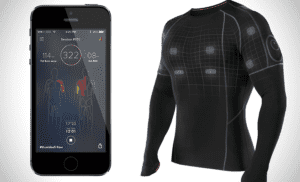
*https://new.whatmobile.net/Opinion/article/smart-clothing-changing-face-wearable-technology
Upon arriving in 2015 in Back to the Future Part II, Marty Mcfly changes into the outfit of the future. His Nike sneakers lace themselves up, automatically adjusting to fit his feet perfectly. His jacket shrinks to fit his arms and even has a self-drying function that is activated after he jumps into the pond during his hoverboard chase with Biff. Later in the movie we even see future-Marty’s kids wearing what we would now refer to as AR or VR goggles. This was the 2015 envisioned in the sci-fi classic. Now in 2020, how close are we to this reality?
The term “wearable tech” covers a wide range of devices that are worn by a user on their body to perform certain functions. They can be divided into three main categories: smart accessories, smart clothing, and healthcare devices. The main functions of these devices are usually for monitoring health-related statistics and acting as an extension of your smartphone, while devices like VR and AR goggles are also used for entertainment.
Today’s wearable technology is not yet as advanced, affordable, and commonplace as Back to the Future imagined they would be by now. However, some ideas have indeed become reality. Nike and various other shoe brands have come out with smart sneakers. VR and AR goggles are gradually becoming a key tool in many industries including gaming, entertainment, even healthcare and manufacturing.
One type of wearable tech that still falls behind the film’s vision is smart clothing. Sadly, Marty Mcfly’s self-tailoring, self-drying jacket is not yet available. Nonetheless, there is promising development in the world of technological clothing.
What is smart clothing?
Smart clothing refers to clothing that has been integrated with technology that can serve its wearer in one way or another. For instance, there are smart socks that collect data of how the user’s foot falls while walking or running. There are also yoga pants that use haptic feedback to detect the accuracy of the wearer’s pose and send small vibrations to prompt the wearer to make adjustments.
In these examples, sensors are woven into the clothing item to collect data. Other types of smart clothing have integrated devices that can screen calls or track one’s location.
What are the next battery breakthroughs that would bring smart clothing into the mainstream?
One current limitation for smart clothing is the size and design of batteries. Even though sensors and control panels can be small, batteries still have bulk and shape to them. Often times a battery pack would have to be attached to the clothing item — an awkward and hard unit that does not seamlessly blend into the clothing article.
There could be a solution to this soon. Battery researches have developed and are testing flexible and stretchable battery packs. This breakthrough would be huge for smart clothing, allowing batteries to be integrated more inconspicuously into the fabric. This would give the user a smoother and more pleasant experience.
There are still limitations to this concept, especially in regards to how stretch can affect battery conductivity and capacity. It is nonetheless promising and could possibly bring us closer to the clothing depicted in Back to the Future.
What other concerns would there be with the batteries of wearable technology and smart clothing? Safety, for one, would be a major consideration. Since these devices are worn on the human body, any overheating or leaking would have direct contact with the skin, posing a major safety hazard. Batteries like solid-state batteries that replace the flammable liquid electrolyte with solid electrolyte could alleviate this concern.
Progress in reducing battery size and increasing capacity would also greatly benefit wearable technology. Although the energy and power demands of smart clothing are not that high, small batteries would help the clothing item feel less like a device and more like futuristic clothing.
Conclusion:
Smart clothing still has some ways to go before it can be integrated into the mainstream. The luxury price point of these items still hinders it from being adopted more widely. Batteries are not the only part of this technology that needs to be perfected, however; given that self-lacing shoes do exist, there is no reason not to believe that a self-adjusting jacket could soon also be available.



